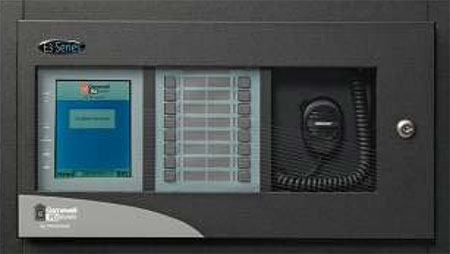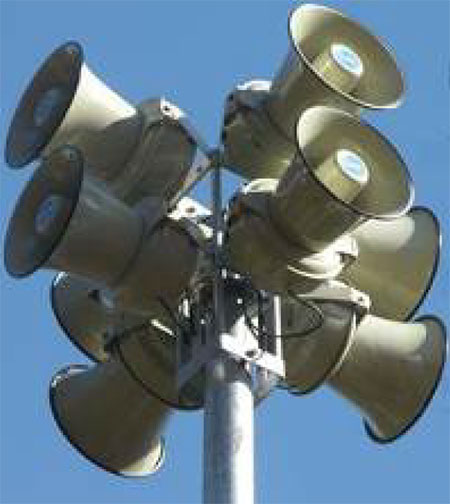Initially seen as a “military solution,” mass notification systems (MNS) are gaining popularity among many non-military occupancies. The NFPA 72: National Fire Alarm & Signaling Code includes a lengthy Chapter 24, which outlines requirements for the design and installation of emergency communication systems (also known as MNS) within commercial facilities. While tragic events such as the Virginia Tech campus shootings and severe weather incidents have raised demand for emergency communications systems (ECS) for commercial properties, the new NFPA codes have begun to set a precedent of utilizing fire alarm systems to support the added duties of a supervised and more survivable ECS.
According to NFPA 72, “security personnel should be able to effect message initiation over the MNS from either a central control station or alternate (backup) control station. Where clusters of facilities exist, one or more regional control stations might also exercise control.” The code also requires that the MNS offer a “dynamic library of scripted responses to various emergency events that would be easily customizable to meet the needs of the individual customer.” These go beyond the requirements of a general fire alarm voice evacuation system.

Photo 1. A Local Operator Console manufactured by Gamewell-FCI includes a remote annunciator touch screen, programmable switches for pre-recorded message initiation and zoned paging, and a microphone for live paging.
To service this need, distributed messaging units commonly referred to as Local Operator Consoles (LOCs) are typically tied to the fire alarm/ECS network and placed throughout a facility or campus to provide authorized users a means for initiating live and pre-recorded announcements, and even text messages.
Distributed recipient notification systems such as email or reverse 911 systems offer alternative methods for alerting occupants. However, these technologies are not supervised for faults or breaks, nor do they encompass a more “survivable” design that would enable the ongoing delivery of accurate communications even if one or more parts of the system’s network are down. Likewise, there are no codes or standards currently in existence that require these systems to be regularly tested and maintained to a specific level of performance.

Photo 2. Giant Voice speaker clusters
NFPA 72 makes clear that distributed recipient notification systems such as text messaging or email shall not be used in lieu of required audible and visual alerting emergency communications systems. This is due to the possibility of delivering conflicting information such as a text message directing a person to remain in-place, while the fire alarm system in the building provides the evacuation message. If the fire alarm evacuation system is activated before the occupants received the message, there could be confusion.
For the same reason, NFPA 72 requires a building’s fire alarm and emergency communications systems be integrated and programmed to allow all ECS functions to supersede the fire alarm. This priority setting avoids the situation of a fire alarm evacuating a building while a message to “shelter in-place” is sent through the same facility’s ECS.
At this point in time, a layered approach using a fire alarm/ECS and an integrated distributed recipient notification system is considered the best solution for reaching the largest number of occupants. However, the sequence of notifications (from all systems) must be considered, and any potential delays in the transmission of communications must be minimized. For these reasons, all systems should be integrated and coordinated with a facility’s emergency plan. [See side bar on risk analysis and emergency planning.]
In the midst of an emergency, flashing strobes accompanied by live or pre-recorded audible instructions tend to have a much higher impact on occupants. At the same time, highly-visual signs in large areas of assembly can offer information specific to the emergency or display a simple message such as “evacuate.” To deliver voice instructions to those outside, large speaker clusters can be installed on the exterior of a building or throughout a campus. Utilizing a combination of audible and visual notification devices, such as strobes, voice communications (indoor speakers and Giant Voice) and programmable LED signage is seen as the most intrusive solution for capturing the attention of occupants and delivering a clear, audible message.

Photo 3. NOTIFIER’s ONYXWorks workstation allows users to remotely monitor and control fire alarm and emergency communications systems via VoIP.
For multiple buildings or campuses spread across a city, state or even the globe, some fire alarm manufacturers such as NOTIFIER have harnessed the latest Voice over IP (VoIP) technology, delivering live voice messages to anywhere in the world via the Internet. These state-of-the-art systems employ one or more workstations from which security or facilities personnel can send emergency communications via VoIP.
Fire alarm system manufacturers and installers work within a tightly regulated industry which was the first to create requirements for the design and installations of ECS for commercial properties. The marriage of ECS and fire alarm control systems is a growing trend that is expected to continue reaching into larger varieties of facilities and multi-building properties, including K-12 schools, high-rise buildings, mass transit hubs and even public gathering places such as theatres, restaurants and places of worship.
Aside from the Unified Facilities Criteria and NFPA 72, the other codes and standards that must be considered in the design of a mass notification/emergency communications system are:
- Americans with Disability Act (ADA)
- OSHA 1910.165, Employee Alarm Systems
- Outdoor Public Alerting Systems, FEMA Guide















Find Us on Socials